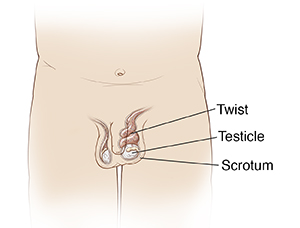Testicular Torsion, Detorsed With Close Follow-Up (Child)
Your child’s testicle was twisted inside their scrotum. This is called testicular torsion. When the testicle twists in this way, the spermatic cord is twisted. Then the blood vessels in the spermatic cord are squeezed (compressed). This reduces blood flow to the testicle. Testicular torsion is a medical emergency.
It's very painful on the side of the affected testicle. It may also cause fever or vomiting. If not treated right away, the testicle can die and will have to be removed. The condition can also lead to problems having children (infertility). If treatment occurs within 6 hours, about 100% of the time the testicle can be saved. After 24 hours, this drops to nearly 0%.
Your child's testicle was untwisted by hand. This is called manual detorsion. This method is used when surgery isn't available within 2 hours. A series of ultrasounds can also be used to check for the return of blood flow to the testicle. If it was not successful, manual detorsion may be done again because the testicle can twist 180 degrees. Your child will still need surgery to stop the problem from coming back. Your child will also need surgery on the other testicle to fix the problem that causes the condition.
Testicular torsion can occur from injury or strenuous physical activity. Or it can occur suddenly.

Follow-up care
Bring your child to a urologist as soon as you can. Ideally, this should be in less than a week. The sooner the surgery is done, the less risk there is of the problem coming back. And there is less risk of possible loss of the testicle or of infertility. If symptoms come back, get your child medical care right away.
When to get medical advice
Contact your child's doctor right away if your child has:
-
Pain or swelling in the testicle or scrotum. If symptoms come back, it's a medical emergency.
-
A fever of 100.4ºF (38°C) or above, or as advised by your child's doctor.
-
Chills.
-
Nausea or vomiting that won't go away.
-
Pain in the belly (abdomen).
-
Trouble peeing.
-
Shrinking of the testicle.
Online Medical Reviewer:
Dan Brennan MD
Online Medical Reviewer:
Lalitha Kadali
Online Medical Reviewer:
Raymond Kent Turley BSN MSN RN
Date Last Reviewed:
4/1/2025
© 2000-2025 The StayWell Company, LLC. All rights reserved. This information is not intended as a substitute for professional medical care. Always follow your healthcare professional's instructions.